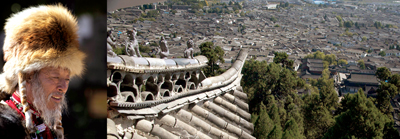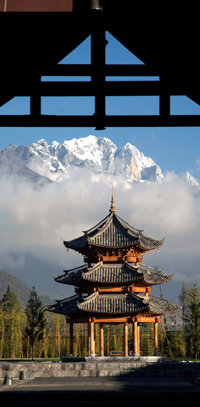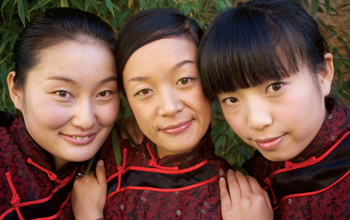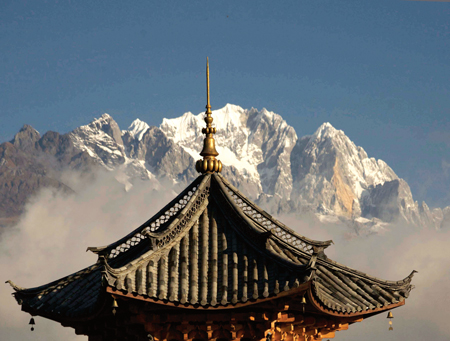Lost Horizon, that classic 1933 novel and movie of the same name, captivated the public with the notion of a far-off utopia removed from the struggles of everyday life. I, too, fell under the spell of the book when I first read it, but I never imagined experiencing any such place. It was, after all, make-believe. Then the opportunity arose to visit a remote corner of China, a valley beyond Lijiang in Yunnan Province among the foothills of the Himalayas. While preparing for the trip, I reread parts of Lost Horizon and came upon the following passage: “But it was to the head of the valley that his eyes were led irresistibly, for there, soaring into the gap, and magnificent in the full shimmer of moonlight, appeared what he took to be the loveliest mountain on earth. It was so radiant, so serenely poised that he wondered for a moment if it were real at all.”
Inspired again by the vision of a magical place, I was determined to see if there wasn’t at least a glimmer of Shangri-La hidden somewhere in China. Coincidentally, enterprising Chinese businessmen in another part of Yunnan had recently gotten government approval to rename their scenic town Xianggelila, a Chinese form of the name Shangri-La.
 I was headed elsewhere, though. Lijiang is some 1,200 miles southwest of Beijing and was settled centuries ago by nomadic Tibetan tribes, whose descendants still maintain their traditional customs, language and dress. Realistically, I didn’t expect to find a modern-day Shangri-La here, but I did hope for a sense of tranquility and natural harmony.
I was headed elsewhere, though. Lijiang is some 1,200 miles southwest of Beijing and was settled centuries ago by nomadic Tibetan tribes, whose descendants still maintain their traditional customs, language and dress. Realistically, I didn’t expect to find a modern-day Shangri-La here, but I did hope for a sense of tranquility and natural harmony.
 My first morning in Lijiang, I woke at dawn, still groggy from my late arrival the previous evening. I shuffled to the bedroom suite’s sliding glass doors and was greeted by the soft light of the rising sun illuminating the jagged peaks of Jade Dragon Snow Mountain. The 18,500-foot massif might not have been Hilton’s “loveliest mountain on earth,” but it was impressive enough to quicken my desire to explore Lijiang.
My first morning in Lijiang, I woke at dawn, still groggy from my late arrival the previous evening. I shuffled to the bedroom suite’s sliding glass doors and was greeted by the soft light of the rising sun illuminating the jagged peaks of Jade Dragon Snow Mountain. The 18,500-foot massif might not have been Hilton’s “loveliest mountain on earth,” but it was impressive enough to quicken my desire to explore Lijiang.
The old town of Lijiang, known as Dayan, dates back more than 800 years, one reason it was named a UNESCO World Heritage Site a decade ago. The neighborhood is a labyrinth of tile-roofed row houses, shops and cafes that line cobbled streets. My first stop was the Museum of Naxi Culture. The museum is rich with displays of Naxi art and crafts and offers the opportunity to see local artisans at work in traditional dress. From a brush painter copying classic Dongba religious scrolls, I learned that this ancient form of the Naxi language, also called Dongba, is the only remaining world language that is rendered in pictographs instead of characters or alphabetic letters.
A stroll to the center of Lijiang took me to the Black Dragon Pool in Jade Spring Park, where exquisite Naxi-style architecture with its ancient Tibetan and Mahayana Buddhist influences is exemplified in the expert exterior and interior Tibetan carpentry of the many gray tile-roofed pagodas and pavilions. Naxi homes, meanwhile, are topped off with menacing fanged guardian creatures to fend off evil spirits from the Buddhist underworld.
Outside town, tucked away from the usual tourist paths, I explored the tranquil valley settlement of Nguluko and found the home of eccentric Austrian linguist, anthropologist, botanist and photographer Joseph Rock, who arrived here in 1922 in search of his own Shangri-La. By the time Rock left in 1949, he had compiled the first Naxi dictionary, collected more than 80,000 plant specimens and led the first field expeditions into the Himalayas for the National Geographic Society, treks he never made without the accompaniment of his bathtub and gold dinner service, which were carried on the backs of porters.
 The next day I made a daylong overland journey from Lijiang to Tiger Leaping Gorge, where the mighty Yangtze River makes a sudden, nearly 180-degree turn. I hiked along a trail blasted and tunneled out of the perpendicular walls of the 10-mile-long gorge, a jagged crevasse that reached a depth of 13,000 feet in some sections. Legend says that at the gorge’s narrowest section (just 33 yards wide) a tiger used a large rock in midstream as a stepping stone to leap from one side to the other.
The next day I made a daylong overland journey from Lijiang to Tiger Leaping Gorge, where the mighty Yangtze River makes a sudden, nearly 180-degree turn. I hiked along a trail blasted and tunneled out of the perpendicular walls of the 10-mile-long gorge, a jagged crevasse that reached a depth of 13,000 feet in some sections. Legend says that at the gorge’s narrowest section (just 33 yards wide) a tiger used a large rock in midstream as a stepping stone to leap from one side to the other.
On my last day in the valley, I visited Baisha Village, the capital of the Naxi Kingdom until 1271. It no longer looked like a place of any importance. In fact, its dusty lanes were all but deserted. As I turned a corner, though, a handwritten sign on a shop front caught my eye. It read, in English, “The Most Admired Man.”
I slid open the door and was greeted with a handshake and a cheery “welcome” in English by a slight, white-bearded Naxi elder. He apologized for his “poor English” (although I considered it quite refined), which he said he learned as a teenager from American airmen who flew with the famed World War II volunteer unit Flying Tigers, which had one of its bases in Lijiang. He wore a black wool sailor’s cap and a white lab coat. He introduced himself as Dr. Ho Shi-Xiu, age 85, a native of Lijiang and a physician. This building was his Jade Dragon Snow Mountain Chinese Herbal Medical Clinic.
Dr. Ho served tea and spoke of his background. After graduating from Nanjing University, he became afflicted with an ailment Western medicine could not treat. He returned home and delved into the study of Chinese medicinal herbs. Eventually, he not only cured himself, but began treating others with natural remedies. Through the years, he said, patients from more than 100 countries have visited him, and medical institutions such as the Mayo Clinic consult with him about his herbal treatment of leukemia.
As I was about to leave, Dr. Ho took his calligraphy brush and with four bold strokes created a single Chinese character on parchment paper—a remembrance of our visit. I asked its meaning. “Kindness,” he said. “My best prescription for good health.”
With the doctor’s parting benediction tucked in my pack, I left Lijiang assured that I had found just what I’d sought in this faraway Shangri-La — not perpetual youth or profound wisdom, but contentment and peace in being more of a blessing to others.
CAPTIONS: (upper, middle) Naxi elder adorned in badger furs; view above gray tile roofs of Dayan Old Town, Lijiang. (middle) Jade Dragon Snow Mountain and Naxi-style pagoda in valley below. (bottom) inquisitive Naxi “best friends.”


